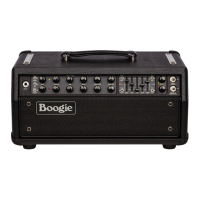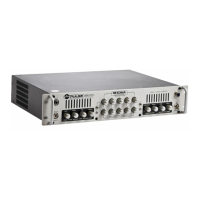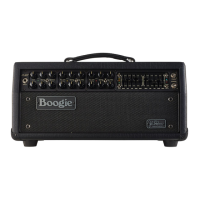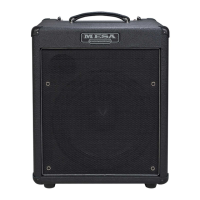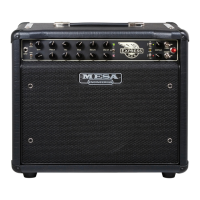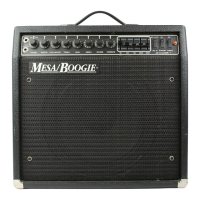PAGE 14
CLEAN produces beautiful, sparkling clean chording sounds between where it starts to sound rich and full at
about 11:00 on up to a richer sounding range that transitions around 2:00 on the GAIN Control to a warmer,
fatter region where clipping begins. You will find the brighter, more open-sounding response at the lower end
of this range, between 11:00 and 12:30. Above 12:30, richness builds in the low mids and lows and begins to fill
in the sound. Above 2:00, gain increases dramatically along with the low end. At the very top end of the GAIN
control, the sound is the fullest in the lows, yet still not as full as the FAT Mode at that GAIN setting.
TONE TIP: If you intend to use CLEAN at that upper end of the GAIN range (past 2:00), it can be helpful to reduce the BASS
control to below 11:00 to retain a defined attack characteristic. With shorter scale instruments and/or mahogany bodies and
necks, especially those fitted with Humbucking pickups, this is an even more important path to balance and great Tone.
FAT
FAT is the other “traditional gain” Mode in Channel 1, and like CLEAN, it excels at clean chording sounds, albeit
of a wider, fatter nature. FAT also sounds great when wound up on the GAIN control …as long as you wind down
the BASS and the MASTER as well to some degree when you’re headed there.
In comparison to CLEAN, the sub-lows are left unfiltered in FAT to round out the response and deliver big,
rich-sounding low end that breathes and a top end that sounds three-dimensional as it sparkles and shines.
This low end, along with the tricks we apply to the top end, creates a beautiful bloom and richness and results
in a truly three-dimensional (clean) chording sound. What this increased airy-sounding low end does for the
top end, and our tricks up top do for the bottom end, is integral to creating the sound of this classic sounding,
wonderful feeling Mode.
While FAT is nearly unbeatable for clean chordal work, it is also very expressive for clean single note and mildly
saturated (Vintage-approved) soloing. FAT smears more easily and uniformly, and the response is smoother as
it transitions in and out of clip, which is perfect for blues, R&B, indie rock, and Americana styles. Some guitars
will want to see the TREBLE set higher (like 2:00) and BASS rather low (below 10:00) for balance and better
control of these more saturated sounds.
Regardless of how you apply FAT, it’s a perfect Mode for your rhythm work as well as a nice color and personality
to have on hand for lead work that isn’t so gained up the character of your guitar is disguised. This versatility
is why we included it twice, once in Channel 1 and again in Channel 2, for an almost limitless palette of choices
and expression in the traditional gain domain.
And don’t forget to explore the further reaches of its scope by combining FAT’s preamp character with the
power options provided by Multi-Watt. Try middle-region GAIN settings with clean playing in the highest power
setting for maximum headroom and sparkle, and conversely, higher GAIN settings (TREBLE higher, BASS and
MID lower) for fury chording and single note soloing in the lowest (25 Watt) power option for added saturation
and harmonic complexity. The FAT Mode covers the full spectrum and gives all the Multi-Watt power settings
something great preamp-wise to work with.
CRUNCH
CRUNCH creates the perfect transitional step between what a traditional gain preamp oers and a high gain
modern preamp can deliver. It occupies the middle zone between clean and overdrive, and for many players,
it may prove the most useful Mode of all in the MARK VII. Knowing this fact, like FAT for clean work, we placed
CRUNCH in both Channels 1 and 2 so that players who would like to use more than one setting of the CRUNCH
Mode can dedicate two of their three footswitchable options to either two dierent settings of CRUNCH, or just
two separate volume levels of the same sound, one for rhythm playing and one for soloing.
CRUNCH starts out at the lower end of the GAIN control’s range, acting like a hopped-up traditional gain preamp.
It will “clean up” nicely in this range despite its mid-biased urgency and “claw.” By 12:00/Noon on the GAIN
control, the more aggressive side of CRUNCH starts to reveal itself with perfect nuanced overdrive. Approach-
ing 2:00 on the GAIN, you’re in classic British territory where chords break up more smoothly and evenly yet
with urgency, and the attack is still fast, crisp, dynamic, and deliberate.
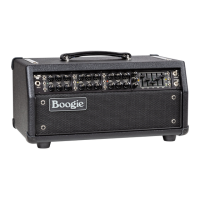
